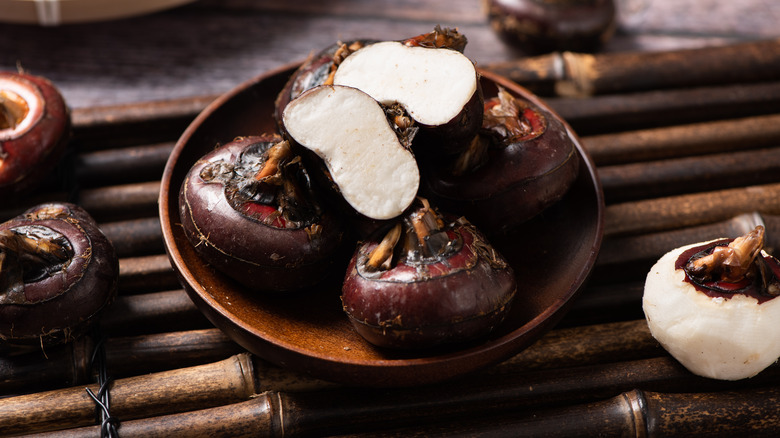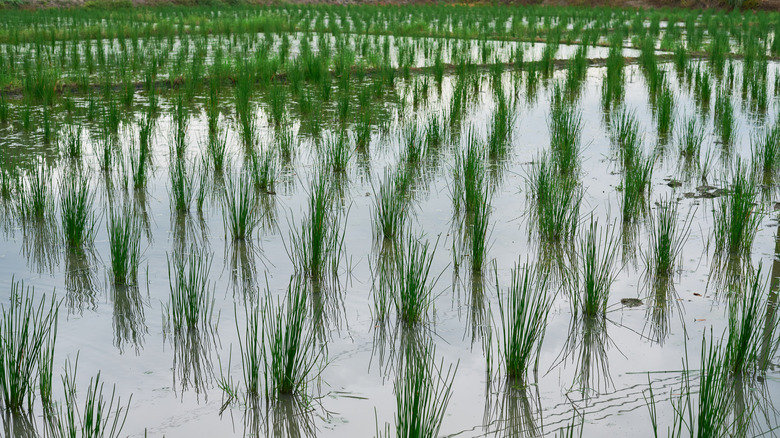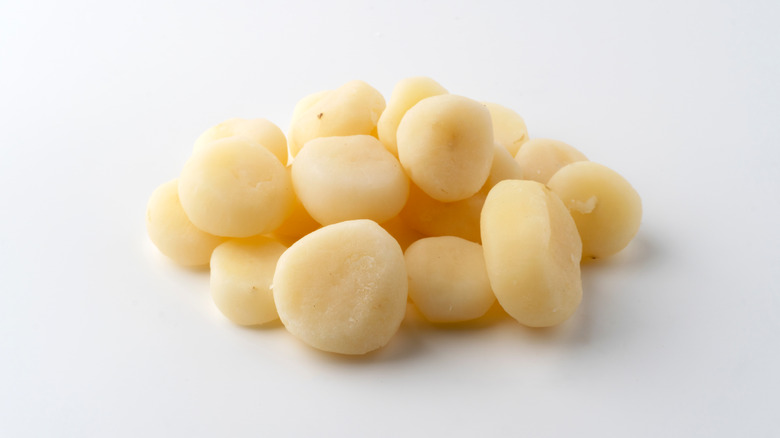Water Chestnuts Aren't Really What They Sound Like
Naming new foods must surely be a difficult task, but we can't help shaking our heads whenever a name really misses the mark. Sometimes it can be amusing, but other times it can cause a good deal of confusion, especially when two unrelated foods are given closely-related names. For example, you have probably heard that peanuts are not actually nuts, but rather legumes, and wild rice is not actually rice (nor is it typically wild). Well, it's time to add another member to this not-so-esteemed group of poorly-named foods: the water chestnut. Not only is it unrelated to the chestnuts roasting on an open fire we always hear about on Christmas, but it's not even a nut to begin with. In fact, the name 'water chestnut' simply comes from the fact that these things look a little bit like chestnuts, being roughly round in shape with brown skin encasing white flesh. That's it. That's the only connection. So, if water chestnuts aren't chestnuts, what the heck are they? The answer might surprise you.
There are multiple kinds of water chestnuts, and they aren't even related
Living in the United States, you're most likely to encounter water chestnuts in Chinese cuisine, used as an ingredient in stir-fries, soups, and chop suey, to name just a few examples. The type of water chestnut used in these cases is known as a Chinese water chestnut, and in its native land, it goes by the names 'matai,' 'pi chi,' and 'pi tsi.' Chinese water chestnuts come from a reedy plant that grows in freshwater sources such as ponds and streams. The edible portion, which we erroneously refer to as a nut, is actually a bulbous stem called a corm. Other examples of corms include crocuses and taro. That's right, and water chestnuts have more in common with taro root than they do with actual chestnuts. Go figure.
There are two other notable kinds of water chestnuts: the European water chestnut (also known as the water caltrop and Jesuit nut) and the Indian water chestnut (also known as the singhara nut). Unlike the more widely-known Chinese water chestnuts, these two other varieties are actually nuts. They look very different as well, having sharp spines on the outside (these are particularly abundant in the European variety). Indian water chestnuts are mainly popular in South Asia, but European water chestnuts have a large presence in the U.S. Unfortunately, it's not as a food; European water chestnuts are an aggressive invasive species, clogging up waterways. They are now illegal in many states.
Water chestnuts are highly nutritious
We're going to return our focus to Chinese water chestnuts, which by far are the most likely to land on your plate. You can purchase them fresh or canned, the latter being cheaper and easier to find in Western stores. Fresh water chestnuts are sweet and nutty with a crisp texture reminiscent of a pear. Canned water chestnuts, on the other hand, have little to no flavor, but they still have the crisp mouthfeel that the fresh ones offer. For these reasons, it is best to use fresh water chestnuts in any dishes where the nut plays a starring role, but when it acts as a player in a large cast of ingredients, as is the case with stir-fries, noodle dishes, and dumplings, the canned variety is an excellent choice.
Water chestnuts are prized for their nutritional value. They are quite low in calories since the flesh is roughly three-quarters water, yet they boast an impressive amount of nutrients. They are particularly notable as a source of fiber and plant-based protein, and they also contain important vitamins and minerals such as vitamin B6, potassium, manganese, copper, and riboflavin (also known as vitamin B2). Water chestnuts have also been found to contain high levels of antioxidants, which combat the oxidative stress caused by free radicals. Such oxidative stress has been linked to heart disease, type 2 diabetes, and multiple forms of cancer, so the healthful appeal is clear to see.


